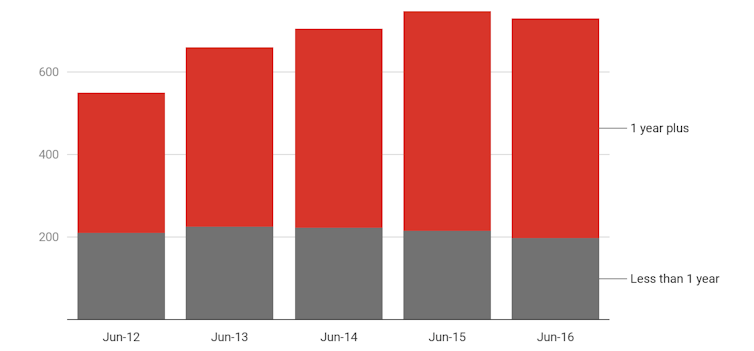
Since parliament has resumed three Liberal members — Dean Smith, Russell Broadbent and Andrew Wallace — have joined a group of Nationals calling for an increase in the $40 per day Newstart unemployment allowance.
Labor has already committed itself to both an inquiry and an increase, although it won’t specify the size of the increase. The Greens have introduced a bill that would increase Newstart by $75 a week.
Defending the current level of Newstart on Monday, Finance Minister Mathias Cormann told the ABC’s Sabra Lane that the payment was “transitional”.
Most Australians were on it for only a “very short period”
LANE: Could you live on 40 bucks a day?
CORMANN: The Newstart allowance which is I guess, what you are now raising is a transitional payment for…
LANE: It is, and you’ve diverted straight away. Could you live on 40 bucks a day?
CORMANN: Newstart allowance is a transitional payment. It is a payment that is increased twice a year. It is indexed twice a year. Most Australians who are on Newstart allowance are on that payment for a very short period.
Greens senator Rachel Siewert actually did try to live on Newstart for a week in 2012.
She introduced the bill that would lift it (and the similarly-sized youth allowance, sickness allowance, special benefit, widow allowance, crisis payment and Austudy) by $75 a week.
On Monday she asked the Senate to “not believe what the government says”:
This is not a transition payment anymore. The employment situation in this country has changed from when the unemployment benefits first came in, and it’s certainly changed since 1994. People have to survive on this payment long-term.
Liberal Wendy Askew responded:
These allowances are not designed as a long-term payment for people, and this is shown by the fact that around two-thirds of job seekers who are granted Newstart exit income support within 12 months.
So what’s the truth? Are most Australians who go onto Newstart on it for only a short time, or are most of those who are on Newstart on it for a long time?
Short term, or long term?
As it happens, both claims are sourced from the same Department of Social Services publication, DSS Payment Trends and Profile Reports.
It says 257,494 Australians went on to Newstart between June 2015 and June 2016. Most of them (191,6800) hadn’t previously been receiving income support.
In the same 12 month period, 274,113 Australians left Newstart, 212,320 of them out of the income support system altogether.
If most of those who went on it in that year also went off it in that year then the government would be correct in saying that “two-thirds of job seekers who are granted Newstart exit income support within 12 months”.
But it would leave most of the rest of the 732,100 Australians on Newstart on it for an increasingly long time.
The table below shows that in June 2016, 73% of Newstart recipients were classified as long-term (one year or more), up from 71% the previous June.
Source: DSS
Graphically, it is possible to see that in June 2016, there were both
- Fewer Australians on Newstart than in the previous year (more had left Newstart than taken it up), and
- A greater proportion of them on it for more than a year.
Number of Newstart recipients by duration on income support, ‘000
 Source: Department of Social Services
Source: Department of Social Services
The apparent contradiction between most of the people who enter Newstart quickly leaving it and most people who are on Newstart being on it for a long time appears to reflect a confusion between flows and stocks.
The International Encyclopedia of the Social Sciences illustrates the difference using a bathtub.
The level of water in the bathtub is a stock, the water coming from the faucet is an inflow, and the draining of the water through the drain is an outflow. If we plug the drain and turn on the faucet, the net inflow will be positive, and the stock of water in the bathtub will be rising. If, instead, we close the faucet and open the drain, the net inflow of water will be negative, and the stock of water in the bathtub will fall.
Between 2015 and 2016 about 260,000 people flowed in to and out of Newstart, and as it happened more flowed out than flowed in.
But those who remained were increasingly likely to have been on Newstart for a long time, probably due to the so-called “scarring” effect that makes people less job-ready (and less attractive to employers) the longer they have been out of work.
Most current Newstart recipients are long-term
The proportion of Newstart recipients on payments for more than a year has climbed from 69% in 2014 to 73% in 2016, and according to the latest Department of Social Services figures, to 76.5% in 2018.
Senator Siewert’s observation that most Newstart recipients have to survive on it long-term is correct.
At any one time the overwhelming majority of the people on the $40 per day have been on it for more than a year.
What’s more, it appears that the decline in the total number of people on Newstart has not been because more of the people on Newstart have been able to get a job, but because the flow into Newstart has slowed.
That is probably a positive development, although there is also the possibility that it is happening because of the onerous compliance burdens of job search, together with the increasing inadequacy of Newstart.![]()
Peter Whiteford, Professor, Crawford School of Public Policy, Australian National University
This article is republished from The Conversation under a Creative Commons license. Read the original article.








It is hugely helpful to have this background – thank you.
I would love to learn more eg
– about stand down times (waiting period before being allowed to submit application and also time elapsing from when the application is submitted and first payment)
– also more about the rates enquiries and decisions go unmet because applicants (and one suspects, staff) are simply unable to navigate Centrelink (calls go unanswered, helplessly wide variation in advice given to callers, wait times at offices, the ability of MPs to ascertain constituents’ circumstances)
For anyone interested in our country cousins, here is a taste of applicant life in New Zealand
https://www.nzherald.co.nz/nz/news/article.cfm?c_id=1&objectid=12246774
If you are over 45 or 50 and have found yourself a victim of ageism you will be on Newstart until you are 67, or if Morrison has his way, 70 years of age. Unless you’re prepared to compete with the slave labour brought in by the Coalition’s mates.
One reason the flow into Newstart might be reducing is that Centerlink is making it harder (if not impossible in some cases), to actually get on it. I know a 21 year old who has lived away from her family for 3 years self- supported in underemployment part time jobs in the city (and has the tax returns to prove it), whilst applying for 100’s of full time positions. Becoming depressed and realising she couldn’t survive, she applied for Newstart, and after a protracted registration, she was then told: (1) that her parents will have to be means tested to see why they are not supporting her, and, (2) why it would be “unreasonable” for her to return home to live with her parents 2500k’s away in a remote area with high unemployment and isolation. Otherwise, she will NOT be considered to have proven her case to receive Newstart. The Government is gate keeping.
This gate keeping is a tool, used extensively, by the government itself and when its work is sub-contracted out, they add a monetary incentive for the contractor, yes, I do mean they pay them a bonus for each perceived failure to comply with the rules, to find fault or breech recipients of parenting allowances.
A breech means a period of time without income or a reduced income.
They are using the same techniques on applicants for assistance packages from the NDIS, which have to be assessed by the understaffed and under resourced NDIA.
If you were trying to survive and look for work on a payment equivalent to $40 a day for say 11, 8 or a mere 6 months, would you consider this to be “a very short period”?
How does “less than 12 months” become deemed to be a short period of time for those who are trying to survive on this amount while looking for work? 2 weeks perhaps, but I would think that even a couple of months is going to have a profound impact on your life and on your ability to find work.
Correct. I was unemployed, looking desperately for non-existent jobs, for 6 months in 1976 (when things were a helluva lot better than they are now for job-seekers). After 6 months my savings were gone, and I was getting close to selling my old car. After that, it would have been losing the rented roof over my head. Had I not had savings, these hard choices would have confronted me after about a month. Politicians are so used to putting their food and accommodation bills onto the unlimited taxpayer tab that they have no idea of what life is like on $40 a day.
If I knew how to do it and to administer it, I would start a crowd funding initiative to shame this cruel government into action. Surely the Christian lobby could help?
Only three topics energise the ‘christian’ lobby. Abortion, same sex marriage and free speech.